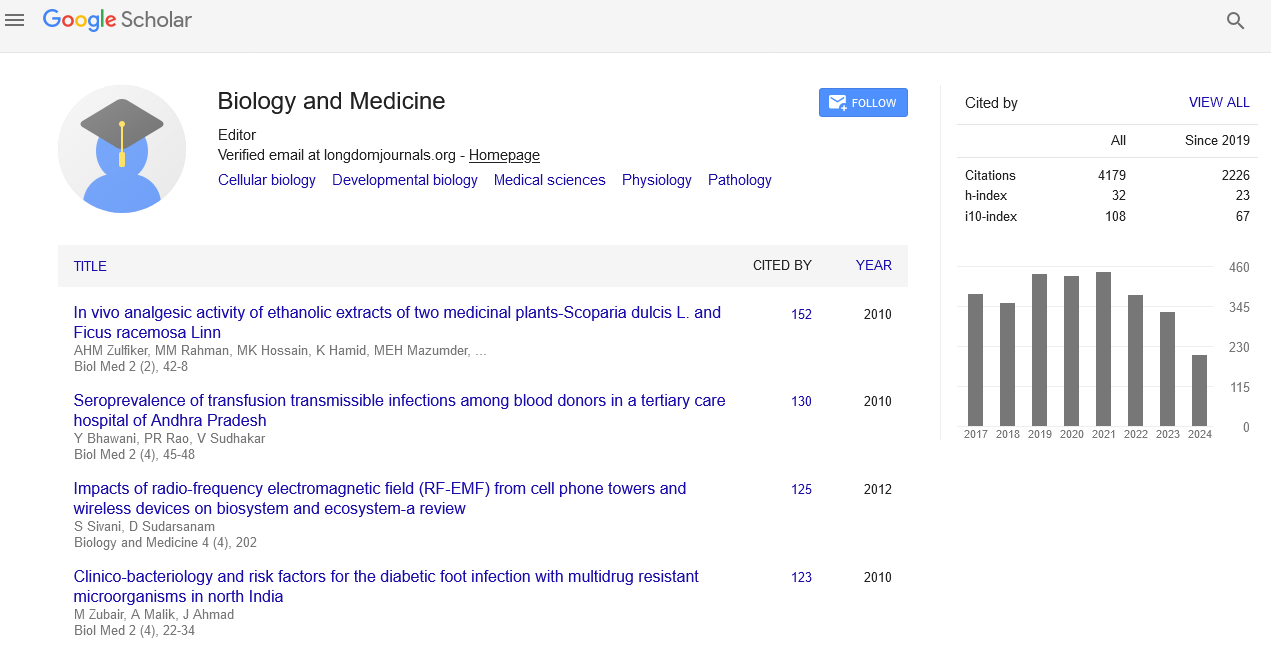Indexed In
- Open J Gate
- Genamics JournalSeek
- CiteFactor
- Cosmos IF
- Scimago
- Ulrich's Periodicals Directory
- Electronic Journals Library
- RefSeek
- Hamdard University
- EBSCO A-Z
- Directory of Abstract Indexing for Journals
- OCLC- WorldCat
- Proquest Summons
- Scholarsteer
- ROAD
- Virtual Library of Biology (vifabio)
- Publons
- Geneva Foundation for Medical Education and Research
- Google Scholar
Useful Links
Share This Page
Journal Flyer

Open Access Journals
- Agri and Aquaculture
- Biochemistry
- Bioinformatics & Systems Biology
- Business & Management
- Chemistry
- Clinical Sciences
- Engineering
- Food & Nutrition
- General Science
- Genetics & Molecular Biology
- Immunology & Microbiology
- Medical Sciences
- Neuroscience & Psychology
- Nursing & Health Care
- Pharmaceutical Sciences
Opinion Article - (2025) Volume 17, Issue 2
Lab-on-a-Chip Devices: Miniaturizing Medical Diagnostics
Noah Varela*Received: 12-Feb-2025, Manuscript No. BLM-25-28804; Editor assigned: 14-Feb-2025, Pre QC No. BLM-25-28804 (PQ); Reviewed: 28-Feb-2025, QC No. BLM-25-28804; Revised: 07-Mar-2025, Manuscript No. BLM-25-28804 (R); Published: 14-Mar-2025, DOI: 10.35248/0974-8369.25.17.777
Description
In traditional laboratory diagnostics, comprehensive tests often require large instruments, skilled personnel, and centralized facilities. This model, while effective, is time-consuming, expensive, and inaccessible to much of the global population. Enter Lab-on-a-Chip technology, a radical innovation that aims to shrink the laboratory onto a microchip, delivering fast, accurate diagnostics at the point of care. LoC systems integrate multiple laboratory functions such as sample preparation, mixing, separation, and detection onto a microfluidic platform no larger than a credit card. These devices are powered by the principles of fluid dynamics at the microscale, enabling precise control and manipulation of small fluid volumes.
Initially developed for chemical analysis and genomics, LoC devices are now being tailored for clinical diagnostics, biosensing, drug discovery, environmental monitoring, and even personalized medicine. Their impact is especially profound in remote and resource-limited areas, where traditional lab infrastructure is lacking.
The backbone of Lab-on-a-Chip devices is microfluidics the science of manipulating fluids in channels with dimensions typically less than a millimeter. Microfluidic platforms offer several unique advantages:
- Reduces cost and conserves precious samples.
- Faster reaction kinetics due to high surface-to-volume ratios.
- Entire workflows from sample to result on one chip.
- Compact and lightweight, ideal for field deployment.
- Multiple analyses can occur simultaneously on the same chip.
Fabrication typically involves soft lithography using materials like Polydimethylsiloxane (PDMS), although more robust and scalable alternatives like thermoplastics and paper are gaining traction.
LoC systems vary in complexity, but most share the following components:
- Microchannels pathways for fluid flow, analogous to lab tubing.
- Micropumps and Microvalves control fluid movement and direction.
- Reaction Chambers areas where mixing, lysis, or amplification occurs.
- Detect target analytes through optical, electrical, or biochemical methods.
- input/output ports, user interfaces, or wireless communication modules.
Advanced chips may include on-chip power supplies, data processing units, or smartphone integration, enhancing portability and ease of use. LoC devices are used for rapid detection of pathogens like HIV, TB, and COVID-19. These devices can perform nucleic acid amplification (e.g., PCR, LAMP) on-chip and return results within minutes. Microfluidic chips can isolate circulating tumor cells (CTCs), detect cancer biomarkers, and analyze tumor DNA. LoC systems aid in early diagnosis, prognosis, and therapy monitoring. Chips can perform hematology tests, including blood cell counts, coagulation profiling, and glucose monitoring. These applications are crucial in emergency medicine and chronic disease management.
Though not diagnostic per se, these platforms mimic the physiology of human organs (like liver or lung) on chips. They are used to test drug responses and model diseases potentially replacing animal models in drug development. LoC systems can detect fetal abnormalities, maternal infections, and neonatal conditions with minimal invasiveness especially useful in field settings or underserved areas.
Conclusion
Lab-on-a-Chip technology exemplifies how miniaturization and integration can disrupt traditional models of diagnostics. These small devices carry the promise of making precision healthcare universally accessible, especially in settings where it is most needed. While challenges remain, the path forward is bright. One of the most promising aspects of LoC technology is its potential to democratize healthcare. In Low and Middle-Income Countries (LMICs), where lab infrastructure is limited, LoC devices offer: These features make LoC tools ideal for Point-Of- Care (POC) testing in rural clinics, refugee camps, and mobile health units. In the future, LoC diagnostic kits may become as ubiquitous as home pregnancy tests or glucometers, empowering individuals to monitor their health in real time.
Citation: Varela N (2025). Lab-on-a-Chip Devices: Miniaturizing Medical Diagnostics. Bio Med. 17:777
Copyright: © 2025 Varela N. This is an open-access article distributed under the terms of the Creative Commons Attribution License, which permits unrestricted use, distribution and reproduction in any medium, provided the original author and source are credited.


